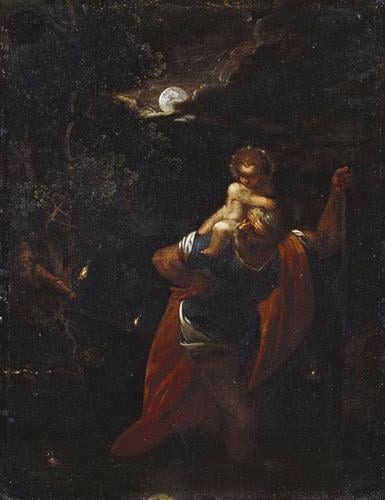Saint Christopher c.1599-1630
Oil on copper | 24.5 x 19.2 cm (support, canvas/panel/stretcher external) | RCIN 400613
-
Though responsible for a small number of small paintings, Elsheimer remains one of the most important artists of the Baroque period, whose influence is felt in the works of (amongst many others) Rubens, Rembrandt and Claude. Trained in Germany, he moved to Venice in 1598 and Rome in 1600; he specialized in miniature paintings on copper with moody landscape elements, spectacular effects of light and unconventional story-telling. Elsheimer’s few works were eagerly sought after by collectors like the Earl of Arundel, who owned a significant group, including the St Christopher which he gave to Charles I. In addition to the three works associated with Elsheimer now in the Royal Collection (RCIN 400613, 400938 & 404717), his Mocking of Ceres (Agnes Etherington Art Centre, Kingston, Ontario) was given to Charles II and subsequently left the collection.
This work treats the story of the giant, St Christopher, persuaded by a hermit to carry travelers across a dangerous river. On one occasion he is awakened by a child who requests a crossing, during which the river swells higher and higher as the child grows heavier and heavier. Once at the far bank, the Child explains why he is so heavy, because he is Christ, the creator of all.
This composition, known in through several versions, dates from his Venetian period, 1598-1600. All versions have a relatively conventional figure style, though with an effect of the body twisted by the weight of the child. The fact that St Christopher needs to be ‘awakened’, has suggested to Elsheimer that this should be a night scene, including his companion hermit with a torch in front of a wayside shrine and two glimpses of firelight in the distance, one reflected in the river. The moon breaking through the stormy clouds, immediately above Christ’s haloed head, provides a metaphor of the Light of the World unveiling Himself to the saint.
The best version of this composition (usually accepted as the original) is in the Hermitage, St Petersburg (copper, 22.5 x 17.5cm). There are two versions in the Royal Collection: one acquired by Queen Mary in 1932 and said to have belonged to Charles I (RCIN 400938, copper 23.2 x 16.4, with a Charles I cypher painted on the reverse) and this one in the Royal collection at least since the 18th century (copper, 24.5 x 19.2). They have been confused (most notably in Keith Andrews’s 1977 catalogue of Elsheimer’s work where the illustrations are incorrectly numbered). They can be distinguished by the form of the Christ Child’s halo – long spikes of light in the Queen Mary picture (RCIN 400938); spots of light in this one. The Queen Mary version is of higher quality, with sharper forms and more jagged contrasts of light and dark; the head of the Christ Child has a slightly ghostly quality, looking like a generalized orb. In this version he has bunched curls and the foliage is also more conventionally treated.
Prior to Queen Mary’s acquisition the inventories of the Royal Collection list one painting of this subject in what appears to be an uninterrupted sequence dating from the reign of Charles I. The picture given to him by the Earl of Arundel appears in the Cabinet Room at Whitehall in 1639 (no 75, measuring 9½in x 6½in or 24.1 x 16.5cm); it reappears in the Commonwealth Sale (sold to Gaspars from St James’s Palace on 22 March 1650 for £33); in the Store at Whitehall in 1666 (no 587, measuring 9in x 6in or 22.9 x 15.2cm); in the King’s Great Closet at Whitehall 1688 (no 652); in the Closet above Stairs at Kensington Palace in 1700 (no 31); thereafter in what is probably the same Closet at Kensington in 1710, 1720 and 1732. It next appears in the Queen’s Work Room at Kew (no 3, 9½in x 7¼in or 24.1 x 18.4cm). There are various explanations for this evidence. this might be the painting belonging to Charles I, which has remained in the collection ever since, joining up the dots listed above (acquiring its typical 18th Century Maratta-style frame on the way). This would mean that RCIN 400938 does not have a Charles I provenance and its brand is spurious; Queen Mary would not be the only collector to have been imposed upon in this way. Both paintings might have belonged to Charles I, one somehow not mentioned in the Sale and perhaps not retrieved at the Restoration. There might be a break in the chain set out above, the weakest link occurring between Kensington Palace in 1732 and Kew in 1805 (only three works appear in both places). RCIN 400938 might have been sold from Kensington by George II and this picture acquired for Kew by George III. This final explanation is the one generally accepted and should be retained (albeit with scepticism) until further evidence emerges.
Being the less good of two copies seems to deliver a judgment on the quality of this painting which is perhaps a little unfair. It looks like an artist (of some quality and a style of their own) copying an Elsheimer composition rather than trying to 'be' Elsheimer.Provenance
Probably acquired during the reign of George III
-
Creator(s)
-
Medium and techniques
Oil on copper
Measurements
24.5 x 19.2 cm (support, canvas/panel/stretcher external)
36.7 x 30.6 x 4.5 cm (frame, external)








